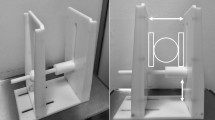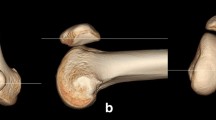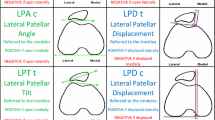Abstract
Fourteen normal volunteers with no history suggesting previous or current knee pathology underwent axial computed tomographic examination of the patellofemoral joint. There were 11 men and 3 women, whose ages ranged from 10 to 46 years (average 25 years). Axial images were obtained at 0°, 10°, 20°, 30°, 40°, and 60° flexion both with and without contraction of the thigh muscles. Thus, 12 images were obtained for each individual. The CT scanner was focused at the midpatellar level prior to each image. Three measurements were made on 24 knees for each individual: congruence angle (CA), patellar tilt angle (PTA), and sulcus angle (SA). PTA increased slightly from 0° to 20°, and decreased slightly with more flexion (not significant, NS). The lower limit of PTA was usually 9°–10°: it was not lower than 7° in any knee position. Muscle contraction increased PTA slightly at each degree of flexion (NS). Mean CA was +18.3° (SD 20.8°) at 0°, which means that normal individuals may have CAs as high as +39° at full extension. There was a gradual decrease in CAs with knee flexion. The mean values became negative between 20° and 60° flexion. Contraction of the thigh muscles caused lateralisation of the patella except at 30° and 40° flexion. This lateral pull was statistically significant at full extension (P<0.01) and at 10° flexion (P<0.05). The SA decreased gradually as the flexion of the knee increased. Angles at 0°, 10°, and 20° flexion were significantly higher than those at 40° and 60° flexion (P<0.05). This study shows that CA, PTA and SA change depending on the degree of flexion of the knee, and that these angles show wide variations in the normal population. One should not rely on axial images taken at full extension, as this may erroneously lead to a diagnosis of subluxation in a normally tracking patella. The values obtained in this study may provide a basis for determining the type of patellar instability at different knee positions, and thus give a better profile or patellar tracking. This is a new concept. Besides, comparison of dynamic values obtained in this study with the ones in abnormal patellofemoral joints may also reveal useful information.
Similar content being viewed by others
References
Aglietti P, Insall JN, Cerulli G (1983) Patellar pain and incongruence. Measurements of incongruence. Clin Orthop 176: 217–224
Brattström H (1964) Shape of the intercondylar groove normally and in recurrent dislocation of the patella. Acta Orthop Scand [Suppl] 68:53
Carson WG, James SL, Larson RL, Singer KM, Winternitz WW (1984) Patellofemoral disorders: physical and radiographic evaluation. II. Radiographic examination. Clin Orthop 185:178–186
Casscells SW (1978) Gross pathological changes in the knee joint of the aged individual: a study of 300 cases. Clin Orthop 132:225
Delgado-Martins H (1979) A study of the position of the patella using computerized tomography. J Bone Joint Surg [Br] 61:443–444
Ficat RP, Hungerford DS (1977) Disorders of the patellofemoral joint. Williams and Wilkins, Baltimore
Fulkerson JP (1982) Awareness of the retinaculum in evaluating patellofemoral pain. Am J Sports Med 10:147
Fulkerson JP, Shea KP (1990) Current concepts review. Disorders of patellofemoral alignment. J Bone Joint Surg [Am] 72: 1424–1429
Inoue M, Shino K, Hirose H, Horibe S, Ono K (1988) Subluxation of the patella. Computed tomography analysis of patellofemoral congruence. J Bone Joint Surg [Am] 70:1331–1337
Kujala UM, Österman K, Kormano M, Komu M, Dietrich S (1989) Patellar motion analyzed by magnetic resonance imaging. Acta Orthop Scand 60:13–16
Larson RL (1979) Subluxation-dislocation of the patella. In: Kennedy JC (ed) The injured adolescent knee. Williams and Wilkins, Baltimore, pp 161–204
Laurin CA, Dussault R, Levesque HP (1974) The tangential X-ray investigation of the patellofemoral joint: X-ray technique, diagnostic criteria and their interpretation. Clin Orthop 144: 16–26
Martinez S, Korobkin M, Fondren FB, Hedlund LW, Goldner JL (1983) Computed tomography of the normal patellofemoral joint. Invest Radiol 18:249–253
Martinez S, Korobkin M, Fondren FB, Hedlund LW, Goldner JL (1983) Diagnosis of patellofemoral malalignment by computed tomography. J Comput Assist Tomogr 7:1050–1053
Merchant AC, Mercer RL, Jacobsen RH, Cool CR (1974) Roentgenographic analysis of patellofemoral congruence. J Bone Joint Surg [Am] 56:1391–1396
Mollar BN, Krebs B, Jurik AG (1986) Patellofemoral incongruence in chondramalacia and instability of the patella. Acta Orthop Scand 57:232–234
Sasaki T, Yagi T (1986) Subluxation of the patella. Investigation by computerized tomography. Int Orthop 10:115–120
Schutzer SF, Ramsby GR, Fulkerson JP (1986) Computed tomographic classification of patellofemoral joint pain patients. Orthop Clin North Am 17:235–248
Schutzer SF, Ramsby GR, Fulkerson JP (1986) The evaluation of patellofemoral pain using computerized tomography: a preliminary study. Clin Orthop 204:286–293
Shellock FG, Mink JH, Fox JM (1988) Patellofemoral joint: kinematic MR imaging to asses tracking abnormalities. Radiology 168:551–553
Shellock FG, Mink JH, Deutsch AL, Fox JM (1989) Patellar tracking abnormalities: clinical experience with kinematic MR imaging in 130 patients. Radiology 17:779–804
Author information
Authors and Affiliations
Rights and permissions
About this article
Cite this article
Pinar, H., Akseki, D., Genç, I. et al. Kinematic and dynamic axial computerized tomography of the normal patellofemoral joint. Knee Surg, Sports traumatol, Arthroscopy 2, 27–30 (1994). https://doi.org/10.1007/BF01552650
Issue Date:
DOI: https://doi.org/10.1007/BF01552650




